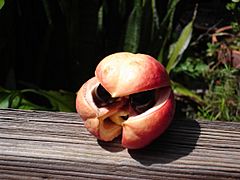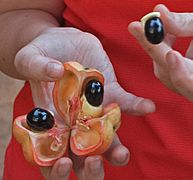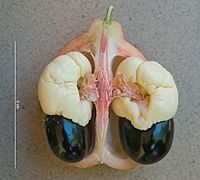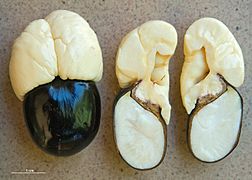Ackee facts for kids
Quick facts for kids Ackee |
|
|---|---|
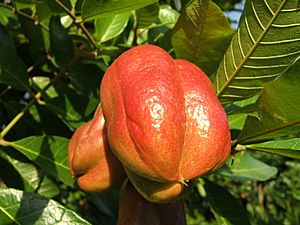 |
|
| Fruit | |
| Conservation status | |
| Scientific classification | |
| Genus: |
Blighia
|
| Species: |
sapida
|
| Synonyms | |
|
Cupania sapida Voigt |
|
| Nutritional value per 100 g (3.5 oz) | |
|---|---|
|
9.55 g
|
|
| Dietary fiber | 3.45 g |
|
18.78 g
|
|
|
Protein
|
8.75 g
|
| Vitamins | Quantity
%DV†
|
| Thiamine (B1) |
9%
0.10 mg |
| Riboflavin (B2) |
15%
0.18 mg |
| Niacin (B3) |
23%
3.74 mg |
| Vitamin C |
78%
65 mg |
| Minerals | Quantity
%DV†
|
| Iron |
42%
5.52 mg |
|
Raw arils after pods allowed to open naturally. Seeds removed
|
|
| †Percentages estimated using US recommendations for adults. | |
The ackee (Blighia sapida) is a special fruit from the Sapindaceae family. This family also includes fruits like lychee and longan. Ackee originally comes from tropical West Africa. Its scientific name honors Captain William Bligh. He brought the fruit from Jamaica to the Royal Botanic Gardens in England in 1793. The name "ackee" comes from the West African Akan word akye fufo.
Even though ackee has a reputation for being poisonous, its edible part, called the aril, is very tasty when ripe and cooked correctly. It's a key ingredient in many Caribbean cuisines. Ackee is the national fruit of Jamaica and is seen as a special food.
Contents
About the Ackee Tree
What the Tree Looks Like
The ackee tree is an evergreen tree. This means it keeps its leaves all year round. It can grow to about 10 meters (33 feet) tall. The tree has a short trunk and a thick, round top, called a crown.
Its leaves are made up of several smaller leaflets. These leaves are about 15 to 30 centimeters (6 to 12 inches) long. Each leaflet is tough and leathery, about 8 to 12 cm long and 5 to 8 cm wide.
Ackee Flowers and Fruit
The ackee tree produces fragrant flowers. These flowers grow in clusters up to 20 cm (8 inches) long. They bloom during the warmer months. Each flower has five greenish-white petals and smells nice.
The fruit itself is shaped like a pear and usually has three sections. As it ripens, its color changes from green to a bright red or yellow-orange. When fully ripe, it naturally splits open. This reveals three large, shiny black seeds. Each seed is partly covered by a soft, creamy white or yellow part. This edible part is called the aril. It tastes a bit like nuts and has a texture similar to scrambled eggs. A typical ackee fruit weighs about 100 to 200 grams (3.5 to 7 ounces). The tree can produce fruit all year, but it's most common from January to March and October to November.
-
Ackee flowers
Types of Ackee
There are many different types of ackee, up to 48! They are usually grouped into two main kinds: "butter" and "cheese" types. The "cheese" type is light yellow and firmer. It's often used for canning. The "butter" type is a deeper yellow and more delicate. It's preferred for certain dishes.
Ackee in Cooking and History
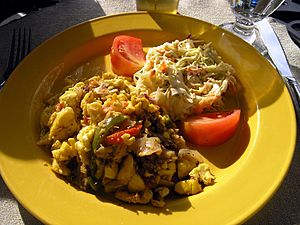
Ackee was brought to Jamaica from West Africa before 1773. Since then, it has become a very important part of Jamaican cuisine. Ackee is the national fruit of Jamaica. The dish ackee and saltfish is even the official national dish of Jamaica.
To be safe to eat, ackee must be fully ripe and open naturally. This is sometimes called "yawning" or "smiling." Once it opens, the black seeds are removed. The fresh, firm arils are then partly boiled in salted water or milk. After that, they can be fried in butter to make a tasty meal. In Caribbean cooking, ackee is often cooked with codfish and vegetables. It can also be added to stews, currys, soups, or rice dishes with different seasonings.
Ackee Nutrition
Ackee contains a good amount of carbohydrates, protein, and fat. About 51-58% of the dry weight of the arils is made up of fatty acids. These include linoleic, palmitic, and stearic acids. The raw, ripe fruit is also a great source of vitamin C.
Ackee in Culture
The ackee fruit is famous in Jamaican mento folksongs. One well-known song is "Linstead Market." In the song, a market seller sadly sings, "Carry mi ackee go a Linstead market. Not a quattie worth sell." The British band The Beat also has a song called "Ackee 1-2-3" on their 1982 album, Special Beat Service.
Important Safety Information: Ackee Toxicity
It's very important to know that unripe ackee fruit can be dangerous. The unripe aril and the parts of the fruit you don't eat (like the seeds) contain natural toxins. These toxins are called hypoglycin A and hypoglycin B. Hypoglycin A is found in both the seeds and the arils. Hypoglycin B is only found in the seeds.
When the fruit is fully ripe, only very small amounts of the toxin remain in the arils, making them safe to eat. However, in unripe fruit, the amount of toxin can be 10 to 100 times higher.
If someone eats unripe ackee, these toxins can cause a serious condition called Jamaican vomiting sickness. This happens because the toxins stop the body from properly breaking down fats. This can lead to very low blood sugar, known as hypoglycemia. This is why it is crucial to only eat ackee that has opened naturally and is fully ripe.
Scientists have found that as the ackee fruit ripens, the seeds help to make the arils safer. The hypoglycin A in the arils changes into hypoglycin B in the seeds. This process lowers the amount of toxin in the edible arils to a safe level.
Ackee in Business
Canned ackee, packed in salty water, is an important product exported by Jamaica, Haiti, and Belize. If new ackee trees are grown from seeds, they will start producing fruit in about 3 to 4 years. If grown from cuttings, they can produce fruit even faster, in 1 to 2 years.
Other Uses for Ackee
Besides food, ackee has other uses in West Africa and some Caribbean Islands. Its "soap" properties can be used for washing clothes or even as a fish poison. The sweet-smelling flowers can be used for decoration or to make cologne. The strong heartwood of the tree is used for building, pilings, oars, paddles, and casks. In traditional African medicine, ripe arils, leaves, or bark were sometimes used to treat minor illnesses.
Ackee Names in African Languages
| Language | Word | Meaning |
|---|---|---|
| Bambara | finsan | akee apple |
| Kabiye | kpɩ́zʋ̀ʋ̀ | akee apple |
| Yoruba | isin | |
| Dagaare | kyira |
See also
 In Spanish: Akí para niños
In Spanish: Akí para niños





